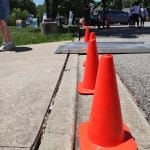Monroe County election board debriefs on day at the polls, provisional ballots to be reviewed June 12



Thursday afternoon, two days after the June 2 primary election, Monroe County’s election board reviewed how things went on Election Day, under the accommodations made to help prevent the spread of the COVID-19 virus.
They also reviewed the accommodations that were made as required under the Help America Vote Act (HAVA), which includes ADA compliance.
For this election at least, the seven polling sites got good marks from disabilities activist Randy Paul. Cones with disability placards were set up to mark off parking spaces closest to whichever entrance that was being used for polling. And temporary ramps were installed in some locations, like a low curb at Grandview Elementary School.
According to the unofficial cumulative results, 26,791 (27.53 percent) of 97,325 registered voters cast a ballot on Tuesday. That’s fewer, numerically and percentage-wise, than for the 2016 primary, when 38,326 (35.32 percent) of 108,517 registered voters turned out.
County Clerk Nicole Browne said at Thursday afternoon’s meeting that some of the other county clerks she’d corresponded with were reporting turnout as low as 15 percent in their counties. She also said Monroe County was not the only county that had waited until the day after the election to report results.
Based on the unofficial cumulative results, 17,785 voters (66.4 percent) cast ballots by mail, 1,963 (7.3 percent) voted in person during the six days of early voting, and 7,043 (26.3 percent) voted in person on election day.
The breakdown by party showed Democrats voting by mail at a higher rate than Republicans. Of the 19,767 Democrats who voted in the primary, 71.5 percent did so by mail compared to 51.2 percent of the 7,024 Republicans who voted by mail.
Provisional ballots aren’t a part of the totals, yet. People who voted with a provisional ballot have until noon on June 12 to rectify whatever problem caused their ballot to be provisional. For example, someone could provide a valid ID they were unable to produce on Election Day.
At 12:01 on June 12, the election board will convene to consider whether the provisional ballots should be counted. Election supervisor Karen Wheeler told the election board that there probably less than 50 provisional ballots to consider. A precise count was not available, because they’re in a sealed bag that can’t be opened until June 12.
Some other ballots that aren’t a part of the totals are those that arrived after noon on Election Day. Board member Carolyn VandeWiele said it’s challenge to get the message across that ballot deadlines are not defined by postmarks as so many other kinds of deadlines are. The ballots have to arrive by the specified deadline—it doesn’t matter what the postmark is. Based on the size of the stack of ballots that Wheeler indicated had arrived after the noon deadline, maybe 100 or so were too late to count.
This year, even getting out the message about the election date was a challenge—it was postponed from May 5 due to the COVID-19 pandemic. Two people arrived at Election Central on Wednesday and wanted to vote.
Expenses for the election have yet to be calculated, because the final bills haven’t come in yet, Browne said. The cost will include mailing out ballot applications and notice of polling location changes to all registered voters in the county, as well as $0.95 return postage for each of the ballots that were mailed in.
Disabilities community activist Randy Paul commented at Thursday’s election board meeting saying that county clerk Nicole Browne should be proud of her team’s work on HAVA compliance.
Election board members and county staff had inspected the seven polling sites—about a quarter the number normally used—and recorded video, which he had then commented on and made suggestions. Paul said it was clear that those involved weren’t just going through a checklist—they were trying to figure out how to improve the accessibility of polling sites.
The board’s discussion turned to the November election and the choice the board faces between the Ellettsville town hall and Edgewood High School. Paul was put off by some “do our best” phrasing, when it came to considering the impact of an in-session school’s drop-offs and pick-ups on the accessibility of parking spaces.
Paul took the phrasing took to be less than a commitment to following the HAVA, which is the law. In a followup email to Paul, election board chair Hal Turner told Paul, “I agree that HAVA and ADA are the law and must be followed. Nothing has changed here.”
Polling sites in Monroe County Election Day June 2, 2020




Comments ()